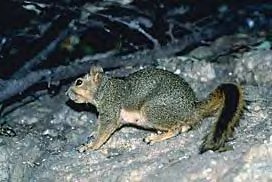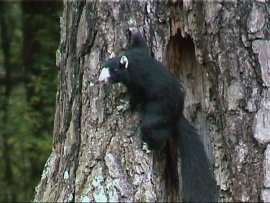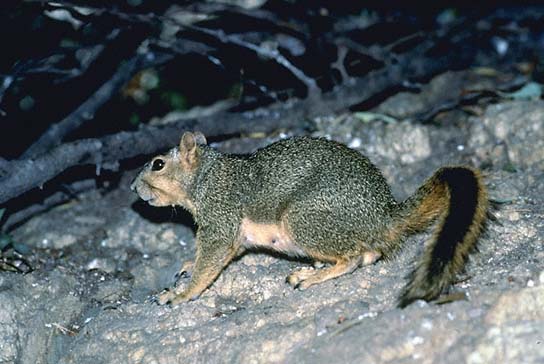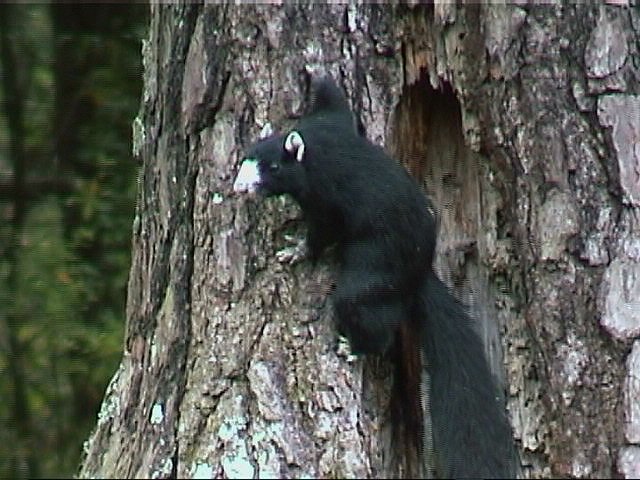Chipmunks, Squirrels, and Prairie Dogs
Description
The largest tree squirrel. 3 color phases: in northeastern part of range, gray above, yellowish below; in western part, bright rust below; in South, dull rust below, grayish brown above; in southeast, black, often with white blaze on face and white tail tip (in North and South Carolina (see photo below), typically black with white ears and nose). Large, bushy tail with yellow-tipped hairs. L 17 7/8–28" (454–698 mm); T 7 7/8–13" (200–330 mm); HF 2–3 1/4" (51–82 mm); Wt 17 3/4–37 1/2 oz (504–1,062 g).
Endangered Status
The Delmarva Peninsula Fox Squirrel, a subspecies of the Eastern Fox Squirrel, is on the U.S. Endangered Species List. It is classified as endangered in Delaware, Maryland, and Virginia. This squirrel once ranged throughout the Delmarva Peninsula. Naturally occurring populations are now found only in parts of Queen Anne's, Talbot, and Dorchester Counties in Maryland, although introduced populations occur elsewhere in Maryland, as well as Virginia, Delaware, and Pennsylvania. This subspecies requires a particular type of mixed hardwood and pine woodland, with a closed canopy and an open understory. It needs extensive forest-edge habitat, so the woodland must be fairly small in extent. Logging practices have altered this type of habitat in the fox squirrel's range, either by changing the nature of the canopy or the understory, or by replacing mixed stands with same-species plantings. Once the Delmarva Peninsula Fox Squirrel loses its own habitat, it must compete with the Gray Squirrel for food and nesting habitat.
Sign
Large leaf nests in trees, fairly well hidden in summer but obvious in winter. Other signs are similar to those of Eastern Gray Squirrel, except that food debris is often much more evident, because fox squirrels commonly carry nuts to a favorite feeding perch such as a low branch, log, or stump, where the ground may be heavily strewn with shells. When squirrels raid cornfields, it may be possible to tell which species is the culprit: The Eastern Fox Squirrel usually cuts and hauls an entire cob to a feeding perch, which is strewn with husks and bits of cob, while the Eastern Gray Squirrel bites the kernels from the cob, then eats only the germ, dropping the remainder.
Habitat
Woods, particularly oak-hickory; in the South, live oak and mixed forests, cypress and mangrove swamps, piney areas. 1 or 2 tree holes per acre (.4 ha) are needed for good habitat.
Range
Eastern U.S. (except New England, most of New Jersey, extreme w New York, and n and e Pennsylvania); east to Dakotas, ne Colorado, and e Texas.
Discussion
The Eastern Fox Squirrel is most active in morning and late afternoon, burying nuts that it will locate in winter with its keen sense of smell, even under snow. This animal eats mainly hickory nuts and acorns, but also tulip poplar fruit, winged maple seeds, ripening corn along wooded areas, open buds, and various berries in season. In the Southeast, its major foods are green pinecones, as well as surface and subterranean fungi. The latter, located by smell, have large numbers of spores, which the squirrel disperses through defecation over several days and much territory. These subterranean fungi are beneficial to the germination and growth of trees, and some contain nitrogen-fixing bacteria. The close relationship between these small mammals and their woodland environment—the forest, the fungi, bacteria—is destroyed by clear-cutting of forest; this constitutes a powerful, although little-understood, argument against the practice.
Although the Eastern Fox Squirrel will feed in common areas, and several individuals may den together in winter, this animal is not very social. It spends much time in trees feeding or cutting down nuts or sunbathing on a limb or in a tree crotch. In fall, it is often on the ground gathering and caching nuts, usually individually or in twos and threes, sometimes establishing larger caches in tree cavities. Where home ranges overlap, more than one squirrel may store nuts in the same general area, or even in the same tree hole. The Eastern Fox Squirrel uses tree holes extensively, particularly in winter, often nesting in them with a family group of several other squirrels. Where tree holes are scarce, the Eastern Fox Squirrel builds leaf nests in tree crotches. These structures, up to 12 inches (300 mm) in diameter, have a side entrance and are lined with shredded material. Such nests are obvious in winter but more difficult to see in summer, when they are green, as they are usually made from the leaves of the tree in which they occur. However, they can be found if one looks for them carefully. Each squirrel usually maintains three to six active nests. Winter mating "chases" are begun by males, who are ready to copulate before females come into heat. A "chase" consists of several males following a female throughout the day (rather than actually chasing her). She mates with one or more of the males. The young, whose eyes remain closed for about a month, keep to the nest for the first seven or eight weeks and become independent of the mother when nearly three months old. These squirrels are relatively easy to locate: one can listen for falling nuts, the swishing of tree branches, chewing sounds, or their call, que, que, que. Eastern Fox Squirrels are becoming much less abundant throughout the Southeast. Fire is favorable to this species, as it helps to remove undergrowth and thus maintains spacing between trees, especially pines, whereas dense hardwood forests and thick underbrush are more suitable for the Eastern Gray Squirrel.




